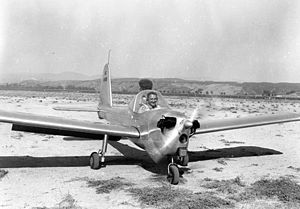Lockheed Little Dipper
| Model 33 Little Dipper | |
|---|---|

| |
| Role | Single-seat utility monoplane |
| National origin | United States |
| Manufacturer | Lockheed |
| Designer | John Thorp |
| First flight | August 1944 |
| Number built | 1 |
| Developed into | Thorp T-211 |
The Lockheed Model 33 Little Dipper, also known as Air Trooper, was an American single-seat monoplane, designed by John Thorp and built by Lockheed at Burbank, California. Flown in 1944 and offered to the Army as a "flying motorcycle", it was evaluated as a potential entry for Lockheed into the civilian market, but the program was cancelled before the second prototype was completed.
Design and development
The design of the Model 33 originated with a private venture for a two-seat light aircraft by John Thorp, a Lockheed engineer.[1] In April 1944, the company agreed to build the aircraft as the Lockheed Model 33.[1] Due to wartime restrictions on materials,[1] the company gained the interest of the United States Army in the aircraft as an "aerial flying motorcycle" to equip a "flying cavalry" under the name Air Trooper.[2] The Army, willing to entertain the concept, authorized Lockheed to build two prototypes of the Model 33.[1]
The Model 33 was of ordinary light-aircraft design, with a low-mounted cantilever monoplane wing and conventional empennage; powered by a 50 hp (37 kW) Franklin 2A4-49 engine, it was fitted with a fixed tricycle landing gear and proved to have STOL performance.[1]
Operational history


The Model 33 prototype first flew in August 1944.[1] The handling characteristics of the aircraft were considered satisfactory,[3] but the Army had lost interest in the concept,[1] despite the prototype demonstrating its performance by landing and taking off again in the courtyard of the Pentagon.[4] Lockheed had intended to market the type as an inexpensive light aircraft on the civilian market as the Little Dipper; with the military interest having evaporated, the prototype and the partially completed second aircraft were scrapped in January 1947 for tax reasons.[1]
Thorp, the aircraft's designer, would go on to develop the Thorp T-211 with lessons learned from the Little Dipper project.[5]
Specifications
Data from Francillion 1982[1]
General characteristics
- Crew: One (pilot)
- Length: 17 ft 6 in (5.33 m)
- Wingspan: 25 ft 0 in (7.62 m)
- Height: 7 ft 0 in (2.13 m)
- Wing area: 104 sq ft (9.7 m2)
- Empty weight: 425 lb (193 kg)
- Gross weight: 725 lb (329 kg)
- Powerplant: 1 × Franklin 2A4-49 two-cylinder air-cooled horizontally opposed piston engine, 50 hp (37 kW)
Performance
- Maximum speed: 100 mph (161 km/h, 87 kn)
- Cruise speed: 91 mph (146 km/h, 79 kn)
- Range: 210 mi (340 km, 180 nmi)
- Service ceiling: 16,000 ft (4,900 m)
- Rate of climb: 900 ft/min (4.6 m/s)
- Takeoff run: 100 feet (30 m); with clearance of 50-foot (15 m) obstacle, 400 feet (120 m).
Text is available under the CC BY-SA 4.0 license; additional terms may apply.
Images, videos and audio are available under their respective licenses.
